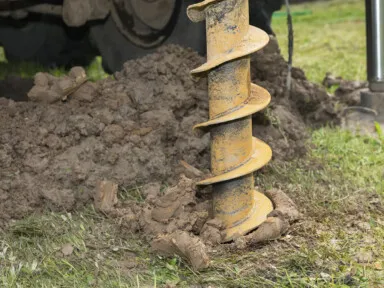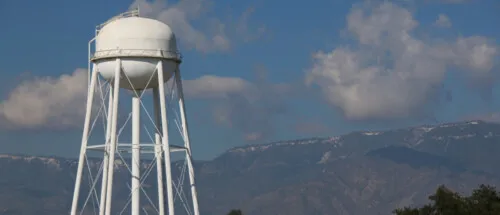What Homeowners Should Consider Before Drilling
Drilling a well can be a worthwhile investment for homeowners looking for a reliable water source, whether for drinking, irrigation, or general use. Understanding how much it costs to drill a well is essential for anyone considering going off city water. Comparing city vs. well water, the latter can provide homeowners with more control over their water supply and lower water utility costs over time.
In 2024, the costs for drilling a well range from $3,000 to $15,000, depending on various factors such as location, well depth, and geological conditions. We’re here to help you navigate the complexities of well drilling costs and help you to make informed decisions about your water needs.
In this article:
- Average Cost of Drilling a Well
- Factors That Influence Well-Drilling Cost
- Additional Well Cost Considerations
- How to Save on Well Installation
- Making the Right Choice for Your Well Investment
Average Cost of Drilling a Well
The average cost of drilling a well varies significantly based on several factors, including location, depth, and soil conditions. Costs can range as low as $3,000 for more straightforward installations in favorable conditions to upwards of $15,000 for deeper wells or those requiring special equipment.
|
Cost Range |
Description |
|
Lowest Cost |
$3,000 (shallow wells, favorable conditions) |
|
Average Cost |
$5,000 – $10,000 (standard depth and installation) |
|
Highest Cost |
$15,000 (deep wells, challenging geological conditions) |
Well-Drilling Cost By Foot
The cost of well drilling changes based on depth. Prices increase for a complete well water system installation, with irrigation wells costing even more. As depth increases, so does the price. Here’s a breakdown of average costs by depth.
|
Depth (Feet) |
Estimated Cost |
|
0-50 |
$3,000 – $5,000 |
|
51-100 |
$5,000 – $7,500 |
|
101-150 |
$7,500 – $10,000 |
|
151+ |
$10,000 – $15,000+ |
Factors That Influence Well-Drilling Cost
Several factors, from geographical location to the specific type of well, can significantly impact the overall cost of drilling a well. Below, we explore the key factors homeowners should consider when budgeting for a new well.
Geographical Location
The cost of drilling a well can vary widely depending on where you live. For example, wells are usually more common in rural areas where costs may be lower due to easier access to equipment and fewer regulations. Meanwhile, well prices are typically higher in urban and suburban areas because of additional permits and/or specialized drilling methods.
Additionally, regional differences in soil type, labor costs, and groundwater availability all contribute to cost variations. For example, the drilling process flows smoother in areas with softer bedrock, leading to lower prices.
Well Type
The type of well also influences the cost. Below, we’ve listed some of the most common well types and their different installation requirements.
- Shallow Wells: Used for smaller water needs and in areas with a high water table.
- Deep Wells: Used when the water table is lower. These wells provide more reliable water access but are more costly.
- Irrigation Wells: Used for agricultural or landscaping purposes.
- Geothermal Wells: Used for geothermal heating and cooling systems.
|
Well Type |
Cost Per Foot |
Total Cost Range |
|---|---|---|
|
Shallow Wells |
$25 – $50 per foot |
$3,000 – $6,000 |
|
Deep Wells |
$30 – $70 per foot |
$8,000 – $15,000+ |
|
Irrigation Wells |
$50 – $100 per foot |
Varies by total depth |
|
Geothermal Wells |
$15 – $40 per foot |
Varies by total depth |
Well Depth
The deeper the well, the higher the cost. Shallow wells are generally less expensive because they tap into water sources closer to the surface. On the other hand, deeper wells can extend hundreds of feet into the ground to access more reliable aquifers. This requires more drilling time, equipment, labor, and potentially more casing and specialized pumps, which can all drive up the total price.
Soil Condition
Soil type also plays a role in the well-drilling process. Rocky and compacted soils, especially soils with hard bedrock, require additional labor and special equipment, increasing costs. But softer soils like sand and clay are faster and easier to drill through, resulting in lower costs.
Distance From House
Generally, the closer the well is to the home, the less expensive it is to install and connect the well system. Additional materials are required to install piping, electrical wiring, and pump systems if the well is located farther away from the house. This also increases labor costs driving up the total price.
Drilling Method
The two most common methods of drilling are rotary and cable tool drilling; choosing between the two depends on the specific conditions of your property. Rotary drilling is ideal for deep wells thanks to its versatility and ability to perform well in a wide range of soil conditions. However, it tends to be more expensive due to the complexity of the equipment. On the other hand, cable tool drilling is more affordable because it uses simpler equipment but may take longer to complete. It is typically used for shallow wells.
Other Well Elements
In addition to drilling, there are a few other essential components to complete your well that can influence overall costs.
- Casing protects the well stream from outside contaminants and provides stabilization to the sides of the well.
- Caps and screens also help with contamination as the first line of defense in keeping foreign objects, nitrates, and other soil contaminants out of your water supply.
- A reliable pump is critical to drawing water from the well. Depending on the well’s depth, you may need a more powerful and expensive pump.
- Storage tanks may be required to hold the water before it is pumped into the home, adding labor and equipment costs.
Permits
Most areas require permits for drilling a new well with prices depending on your location. Permit fees typically range from $500 to $3,000, depending on local regulations and project complexity. The permitting process often includes environmental assessments, inspections, and adherence to local codes, which can add to the overall cost of the well installation.
Additional Well Cost Considerations
Beyond the initial drilling and installation, several other factors can influence the overall cost of a well system. These additional elements, from pump installation to water filtration, ensure the well operates efficiently and safely.
Well Pump Installation
The cost of installing a well pump depends on the type and depth of the well. Following the general trend with most other well counterparts, shallow wells generally require less expensive pumps, while deep wells need more powerful submersible pumps. Homeowners can expect to pay between $500 and $2,000 for well pump installation.
Septic System Installation
A septic system is essential for managing wastewater, and if your property isn’t connected to a municipal sewer system, you may need to install one alongside your well. Depending on the system size and soil conditions, the cost of this installation can range from $3,000 to $10,000 or more.
New vs. Old Well
If you already have an old well that just needs updates, you’re in luck! Adding necessary renovations to your existing well might involve replacing the pump, re-casing, or re-drilling a section of the well. Depending on the extent of the repairs, the cost can range from $1,000 to $5,000. However, if an old well has significant problems like structural failure or contamination, starting from scratch may be more cost-effective and safe.
As we’ve covered, drilling a new well involves permits, land assessments, and careful consideration of factors like soil conditions, well depth, and the type of drilling method, all of which contribute to the overall cost and complexity of the project.
Storage Tank Installation
Storage tanks hold water before it’s pumped into the home, ensuring there are no water shortages. Depending on the tank’s size and material, the cost of installing a storage tank ranges from $500 to $3,000. Larger tanks, which can hold thousands of gallons, are more expensive but may be necessary for homes with high water consumption.
Water Filtration System
Installing a water filtration system helps ensure water from your well is safe for drinking and household use. Proper filtration systems remove bacteria, chemicals, and other harmful substances that may be present in well water. There are various types of water treatment, like reverse osmosis, carbon filters, or UV purifiers, that homeowners may need to install depending on the local water quality. The cost of installing a water filtration system can range from $1,000 to $4,000, depending on the system’s complexity and the specific contaminants it targets.
Additionally, homeowners might want to invest in a water softener to enhance the quality of their well water, particularly if it contains high levels of minerals like calcium and magnesium. Depending on the system’s capacity and features, a water softener can cost from $400 to $2,500.
Water Testing
To ensure your well water is safe for drinking, local health departments require homeowners to test their water at least once a year but sometimes more frequently for contaminants such as bacteria, heavy metals, and chemicals. Water testing kits can cost between $30 and $150, and professional testing services, which are more thorough, may cost $100 to $500. For example, Leaf Home offers advanced water testing that shows exactly what’s in your water.
Maintenance
Drilling and managing your well is a significant investment, and it doesn’t end after installation. Investing in routine maintenance helps prevent costly repairs in the future and guarantees that the well continues to provide reliable water. Maintenance tasks include periodic inspections of the well pump, cleaning the well casing, and checking the water quality. Depending on the complexity of the system, regular maintenance costs can range from $100 to $500 per year.
How to Save on Well Installation
While drilling a well is not your average home improvement task, many people enjoy having control over their water supply. Here are several strategies homeowners can use to reduce costs without sacrificing quality.
Keep It Close To Home
One of the easiest ways to save on well installation is to position the well as close to your home as possible. By shortening the distance, you can reduce labor and material costs, making the project more affordable.
Make It Shallow
Opting for a shallow well can significantly reduce costs. Shallow wells are less expensive to drill because they require less labor, equipment, and materials. However, it’s important to ensure that the water table is high enough to support a shallow well while still providing reliable water access.
Use Quality Materials
With well drilling, it’s important to play the long game. Choosing cheap, low-quality materials can lead to costly repairs or replacements in the future, as poor equipment tends to break down faster and may lead to expensive repairs or replacements. Investing in high-quality materials for key components like the well pump, casing, and piping may be more expensive upfront, but it will save you from bigger expenses later on.
Compare Quotes
Always compare quotes from multiple well drilling contractors to ensure you get the best deal. Pricing can vary widely depending on the contractor’s experience, location, and project specifics. Getting at least three quotes allows you to make a more informed decision and avoid overpaying for the installation.
Making the Right Choice for Your Well Investment
Installing a well is a substantial investment, but it provides a long-term, reliable source of clean water for your home. From understanding the factors that influence costs—such as well depth, drilling method, and geographical location—to exploring ways to save on installation, homeowners have plenty of options to tailor the project to their needs and budget. By taking these considerations into account, you can ensure a smooth, efficient installation process.
If you’re planning to drill a new well or upgrade an existing system, consider scheduling a professional water test to ensure the safety and quality of your drinking water. The trusted pros at Leaf Home Water Solutions provide free water testing and an informative consultation to each interested customer so that you can choose the best system selection for your home’s water needs.Contact Leaf Home to schedule your consultation.
Frequently Asked Questions (FAQs)
How much should I budget for a well?
The cost to drill a well can vary depending on factors like well depth, location, and the type of system being installed. For shallow wells, homeowners can expect to budget from $3,000 to $5,000, but as the well gets deeper and or becomes geologically complex, prices may be closer to $10,000 to $15,000.
How deep should a well be for drinking water?
For drinking water, wells need to reach an aquifer with a stable supply. Shallow wells are usually around 25 to 50 feet deep, while deep wells can range from 100 to 300 feet or more, depending on local groundwater levels and water quality.
What is the cheapest way to drill a well?
The most cost-effective way to drill a well is to choose a shallow well if your water table allows for it. Additionally, keeping the well close to your home and comparing quotes from multiple contractors can help reduce costs. However, it’s important to prioritize safety over savings—investing in quality materials and professional installation ensures your water supply is reliable and safe.
How many years does a water well last?
A properly constructed and maintained well can last for 30 to 50 years or more. However, individual components, such as pumps, may need replacement every 10 to 15 years. Regular maintenance and water testing are essential for extending the well’s lifespan.
Can you drill a well anywhere?
Not all locations are suitable for well drilling. Factors such as soil type, water table depth, and local regulations can determine whether a well can be drilled in a specific area. Consult with a professional well-drilling contractor to assess your property and ensure compliance with local laws.




